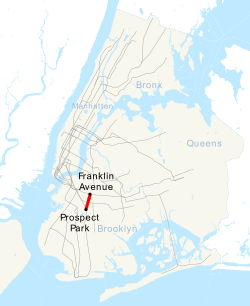Franklin Avenue Shuttle
| Franklin Avenue Shuttle | |
|---|---|
 | |
|
Franklin Avenue Shuttle train of R68 cars at its north terminus, Franklin Avenue-Fulton Street. | |
 | |
| Northern end | Franklin Avenue |
| Southern end | Prospect Park |
| Stations | 4 |
| Rolling stock | 4 R68s (2 trains) |
| Depot | Coney Island Yard |
| Started service |
1878 (predecessor, along with current Q route) 1963 (current shuttle) |
The Franklin Avenue Shuttle is a New York City Subway shuttle service operating in Brooklyn. The shuttle service uses the BMT Franklin Avenue Line exclusively. The north terminus is Franklin Avenue, with a transfer available to the IND Fulton Street Line. The south terminus is Prospect Park, with a transfer available to the BMT Brighton Line. The shuttle runs One Person Train Operation with the motorman also being the conductor. The motorman will go to the opposite end to make another run at each terminal.
NYCT Rapid Transit operations refer to it internally as the S or FS.[1] Like the other two shuttles, 42nd Street in Manhattan and Rockaway Park in Queens, its route bullet is colored dark slate gray on route signs, station signs, rolling stock, and the official subway map.
The S has four stations as of 1999.[2] Consumers Park was closed in 1928 and replaced by the current Botanic Garden station five blocks to the north. There is a visible clearing at the former station location. Dean Street was closed in 1995 due to low paid fare entrance and fare beating.
The shuttle runs two 2-car train sets of R68 subway cars. Trains usually pass each other at Botanic Garden, the only 2-track station on the Franklin Avenue Line, leaving a passing loop while en route to Park Place.
History
Early history
The current service is co-extensive with the BMT Franklin Avenue Line. It parallels Franklin Avenue, hence the shuttle's name (and the name of the line). It was originally a part of the mainline of the BMT Brighton Beach Line and opened as part of that steam railroad line in 1878.[3][4][5]
On November 1, 1918, a five-car wooden elevated train left the tracks and crashed into one of the new tunnel walls, killing at least 93. This accident, called the Malbone Street Wreck, was among the worst rapid transit disasters ever.[6]
The mainline was shifted in 1920, with subway trains from Manhattan and elevated trains from Franklin Avenue sharing operations to Coney Island.[7][8] After the city gained ownership of the line in 1940, Brighton-Franklin services gradually declined. A major blow to through service viability occurred in 1954 when the D train of the IND Division was extended to Coney Island via the Culver Line, deprived the Franklin of a major source of transfer traffic, consisting of passengers from Harlem and the Bronx, who now had a more direct route to Coney Island.[9][10]
Truncation
Brighton-Franklin express service ended by 1959, and the Franklin Avenue Line became a full-time shuttle in 1963. On November 1, 1965, when R27s started going into service, this service was named SS, and in 1985, when the practice of using double letters was eliminated, this service became the S.[9][10]
On December 1, 1974, a southbound shuttle train of R32s was approaching the tunnel portal en route from Franklin Avenue when it derailed on the crossover and smashed the same place where BRT car 100 had hit in the Malbone Street Wreck. This derailment resulted in some injuries, but there were no fatalities, because time signals limit the speed of trains coming down the hill from Crown Heights.[9]
Deterioration and renovation
In 1981, the MTA proposed abandoning the service under the failed Program for Action. At the time, only 10,000 passengers used the shuttle per day, and in addition, the Franklin Avenue Line was severely deteriorated. It was proposed that bus service along nearby Franklin Avenue could substitute for the line.[9] During the winter, the line would often be closed because there was fear that trains would derail. Stations were in horrible condition; portions of the wooden platforms were sealed off because they had burned or collapsed.[11][12] In January 1982, the line needed to close for emergency repair work because a retaining wall along the line was in danger of collapse.[13]
In the 1990s the Franklin Avenue Shuttle was known as the "ghost train". It was shrunk in size to only two cars, and the Dean Street station, which had 50 paying riders per day, was closed in 1995.[9][14] The entire line was under consideration for abandonment, and community leaders were opposed to the move. They showed up to town hall meetings, news conferences and they sat down with transit officials. They also formed the Committee to Save the Franklin Avenue Shuttle. The coalition included the Straphangers Campaign, a local church, local community boards and the New York City Environmental Justice Alliance. They argued that subway station repair work occurred elsewhere, when no attention was paid to the Franklin Avenue Shuttle.[15]
In the end they convinced the New York State Assembly to force the MTA to rebuild rather than abandon the line, and as a result most of the supporting infrastructure and stations were completely rehabilitated for eighteen months, between July 1998 and October 1999 at a cost of $74 million.[16][2][17] While the closure of the line started in July 1998, work began in September 1997.[18] During the renovation, a temporary shuttle bus and the B48 bus replaced train service.
The line reopened on October 18, 1999, three months ahead of schedule. The new line included new tracks and bridges, three rebuilt stations, elevators, security cameras, and new artwork. The transfer to the IND Fulton Street line had required an out-of-system paper transfer, but an enclosed transfer was built with two elevators and an escalators.[7][17][19] Prior to this enclosed transfer, a portion of the old Fulton Street Elevated line was left standing so passengers could use a staircase to transfer to the Fulton Street subway; the transfer at Fulton Street had been made (in both directions) by retrieving a small cardboard transfer ticket from the token booth or a ticket machine, exiting to the street, and entering the other rail line and depositing the ticket in a box and walking onto the platform.[20] The Dean Street station, closed in 1995, was demolished.[14] A new passageway was created to provide transfers to the IRT Eastern Parkway Line at Botanic Garden. MetroCard vending machines were also installed in the stations, and new speakers were installed to make announcements more audible.[21] Once the line was reopened there were still calls to restore the Dean Street station, and there were complaints that the Botanic Garden and Prospect Park stops were not made ADA accessible; Prospect Park was made accessible in a later project.[22]
Stations
For a more detailed station listing, see BMT Franklin Avenue Line.
| Station service legend | |
|---|---|
| |
Stops all times |
| |
Stops all times except late nights |
| |
Stops late nights only |
| |
Stops weekdays only |
| |
Station closed |
| Time period details | |
| |
Stations | |
Subway transfers | Connections |
|---|---|---|---|---|
| Brooklyn | ||||
| Franklin Avenue Line | ||||
| |
Franklin Avenue | |
A |
|
| |
Park Place | |
||
| |
Botanic Garden | 2 |
||
| |
Prospect Park | |
B |
|
References
- ↑ "GENERAL DISTRIBUTION - SUB-DIVISION B - TRAIN OPERATOR/CONDUCTOR - ROAD & NON-ROAD WORK PROGRAMS" (PDF). New York City Transit Authority. July 29, 2016. Retrieved August 19, 2016.
- 1 2 Wilson, Michael (24 July 2008), "In Brooklyn, It's the Little Train That Can", New York Times, ISSN 0362-4331, retrieved 2008-07-27
- ↑ "The lore of the FRANKLIN AVENUE SHUTTLE - Forgotten New York". forgotten-ny.com. Retrieved 2016-06-21.
- ↑ "Joint LIRR / BRT Elevated/Rapid Transit Service". www.lirrhistory.com. Retrieved 2016-06-21.
- ↑ "BRIGHTON BEACH LINE Part 2". www.arrts-arrchives.com. Retrieved 2016-06-21.
- ↑ Cudahy, Brian J. (1999-01-01). The Malbone Street Wreck. Fordham Univ Press. ISBN 9780823219322.
- 1 2 "The Third Rail - The New Franklin Shuttle - Preface". www.thethirdrail.net. Retrieved 2016-06-21.
- ↑ Cudahy, Brian J. (1999-01-01). The Malbone Street Wreck. Fordham Univ Press. ISBN 9780823219322.
- 1 2 3 4 5 Cudahy, Brian J. (1999-01-01). The Malbone Street Wreck. Fordham Univ Press. ISBN 9780823219322.
- 1 2 "NYCT Line by Line History". www.erictb.info. Retrieved 2016-06-21.
- ↑ "The fight to save the Franklin Avenue Shuttle". www.straphangers.org. Retrieved 2016-06-21.
- ↑ Finder, Alan (1992-03-16). "Transit Authority Switches Tracks". The New York Times. ISSN 0362-4331. Retrieved 2016-06-21.
- ↑ Goldman, Ari L. (1982-01-22). "FRANKLIN AVENUE SUBWAY SHUTTLE IN BROOKLYN IS CLOSED FOR REPAIRS". The New York Times. ISSN 0362-4331. Retrieved 2016-08-05.
- 1 2 "Abandoned Stations : Elevated Stations". www.columbia.edu. Retrieved 2016-06-21.
- ↑ "MTR 10, Franklin Ave Shuttle Site of Leafletting Action". www.tstc.org. Tri-State Transportation Campaign. November 9, 1994. Retrieved 2016-06-21.
- ↑ "The Third Rail - The New Franklin Shuttle - Preface". www.thethirdrail.net. Retrieved 2016-06-21.
- 1 2 Faison, Seth (June 20, 1993). "Hope for Overhaul Dims on a Crumbling Subway Line". The New York Times. Retrieved August 5, 2016.
- ↑ "MTA | Press Release | MTA Headquarters | New Franklin Avenue Shuttle Makes Early Debut". www.mta.info. Retrieved 2016-06-21.
- ↑ "About NYC Transit - History". 2002-10-19. Retrieved 2016-09-18.
- ↑ "The lore of the FRANKLIN AVENUE SHUTTLE - Forgotten New York". forgotten-ny.com. Retrieved 2016-06-21.
- ↑ Lueck, Thomas J. (1999-10-18). "Subway Shuttle Gets $74 Million Makeover". The New York Times. ISSN 0362-4331. Retrieved 2016-06-21.
- ↑ "NEW FRANKLIN AVE. SHUTTLE REOPENS AFTER 74M OVERHAUL". NY Daily News. Retrieved 2016-06-21.
External links
Official websites
- MTA NYC Transit – Franklin Avenue Shuttle
- "S Subway Timetable, Franklin Av Shuttle, Effective November 7, 2016" (PDF). New York Metropolitan Transportation Authority. Retrieved November 7, 2016.
Fan sites
- Station Reporter - Franklin Avenue Shuttle
- Arrt's Arrchives - Brighton Beach Line (The Franklin Avenue Shuttle)
- nycsubway.org – BMT Brighton Line:
- Railfanning on the Franklin Ave. Shuttle (S) on YouTube
- Backfanning on the Franklin Avenue Shuttle on YouTube




